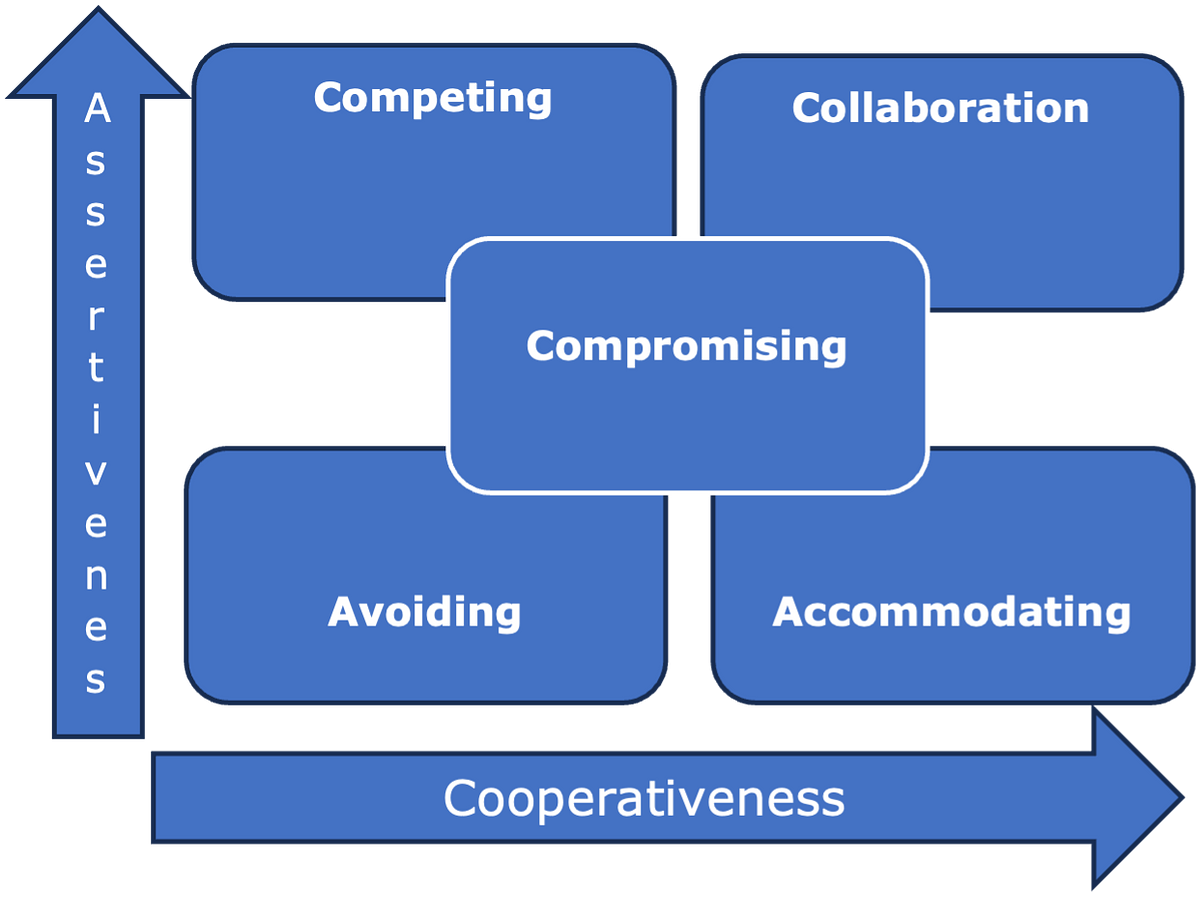Professionals and Practitioners
This digital resource tells the story of how our brains interpret the world around us and how this translates in our bodies, emotions and behaviours. It has been designed to be used by professionals working with young people interested in learning more about the science of conflict and boosting their wellbeing.

Conflict Approaches
Summary
- Defining conflict provides a term of reference we can use to think about what causes it and how we can work towards mitigating it.
- People need sense of control and predictability to respond to conflict effectively.
- Conflict approaches can include mediation and facilitation, crisis intervention, restorative intervention, community input and advocacy.
- There are five established conflict approaches response styles that people use in conflict resolution: competing, avoidance, compromise and collaboration.
- Conflict doesn’t have to a barrier between people; it can provide an opportunity for positive change.
What is conflict?
Cyrenians Scottish Centre for Conflict Resolution’s working definition of ‘conflict’ is:
Conflict can arise when there are disagreements over: views, values or actions and interests or needs are not being met. Conflict can also be an opportunity for change.
‘Conflict’ has many definitions. By defining conflict, we can begin to recognise and acknowledge the triggers that lead to its potential escalation and so begin to think of responses to manage it.
When ‘conflict’ manifests, it can cover a broad spectrum that includes feelings, emotions, parties involved, environment, timing, communication, resources, experience and so on. It can be a simple or complex matter, constructive or destructive, quick or protracted, and will be unique to the relationship that has generated it. Those involved in the conflict are, in a sense, the experts on that particular conflict; the question is – what can we learn from their expertise to effectively improve the relationship?
What we do know is that all relationships experience conflict, mainly low-level constructive conflict which normally is managed and resolved. Acknowledging this means that we all have conflict resolution skills that can be built on and developed with the appropriate support and guidance.
Unresolved conflict can impact relationships negatively, affect individual wellbeing and development, and involve the wider community. ‘Conflict approaches’ provides methods that can help facilitate the management of conflict to assist you in your practice delivery in supporting those who connect with your services.
What are ‘conflict approaches’?
Everybody responds to conflict and difficult situations differently; ‘fight or flight’ reactions, for example. Studies show that when people have control, but the situation lacks predictability, then that leads to a ‘fight’ response.
If a person feels they lack control and the situation lacks predictability, then the person will choose a ‘flight’ response. Here, a person’s perception that non-engagement is the best option with regards to their self-preservation drives their response.
The challenge, then, is this: how do we empower individuals so that they feel that they have a level of control over emotions and outcome? How do we boost their understanding of how to progress towards workable solutions to provide some predictability of outcomes?
Interpersonal, relationship conflict is an inherent part of working with people. Whether you’re a social worker, support worker, youth worker, or teacher, understanding conflict and having effective responses to it is crucial.
People need a sense of control and predictability to respond to conflict effectively.
Types of conflict approaches
‘Conflict approaches’ are those responses that can be applied to manage some of the interactions that play out in a conflict.
The key approaches include:
1. Mediation and Facilitation
· Mediation, simply put is a neutral third party that creates opportunities and manages discussions between conflicting parties. There are a number of different types of mediation models that can be applied depending on the setting. The purpose of mediation is to facilitate communication, promote understanding between parties, identify unmet needs, and explore and agree mutually acceptable solutions. The benefits empower conflicting parties to find common ground and maintain, strengthen even, relationships.
· Family Group Conferencing (FGC) gathers all the relevant parties involved to address the issues relating to the conflicts collectively and collaboratively. It encourages shared decision making, gives people a voice, respects contributions and diverse perspectives, highlights collective responsibility, and agrees next steps.
2. Crisis Intervention
As the title suggests, this intervention swiftly responds to crises, for example, domestic abuse. This approach prioritises safety, stabilising the situation and resourcing.
3. Restorative Interventions
Restorative interventions address the behaviours and harm caused by conflict. It focusses on accountability and rebuilding trust, developing empathy and understanding.
4. Community and advocacy
· Community-organising requires engaging with the community to deal with any systemic issues contributing to conflicts. It can empower people into action, advocate for change and develop social support, strengthening the community and preventing further or future conflicts.
· Advocacy provides a voice championing individual rights within organisations and bodies to ensure fair and just treatment, access to services and active participation. It can promote social justice and equity.
Conflict approaches response styles
Responding to conflict can be challenging irrespective of how experienced or qualified you are. For most, if not all of us, dealing with interpersonal, relationship conflict scenarios is not something we relish.
For some, though, it is a daily practice.
After World War II, conflict resolution became a focus within the behavioural sciences, focussing on how people resolved conflicts. Within this field of study, it was agreed that five prevailing approaches existed which have been accepted across the professions related to conflict resolution.
The five established approaches are:
1. Competing
2. Accommodating
3. Avoiding
4. Collaborating
5. Compromising
These approaches were further developed in the 1970s by Kenneth Thomas and Ralph Killman by assessing how individuals processed and achieved conflict resolution. Their findings were published, and the Thomas-Killman Instrument (TKI) was created, consisting of a short test that determined an individual’s conflict resolution profile.
Thomas-Killman suggests that “’Conflict situations’ are those in which the concerns of two people appear to be incompatible”. They map an individual’s behaviour along two axes in such situations: assertiveness (self-serving) and cooperativeness (needs of the other).
Within these axes the approaches are introduced:

The approaches or styles are all appropriate in the relevant conflict scenario and are fluid as we respond to the nature of the conflict as it changes. For example, an individual may be responding to conflict by using a ‘competing’ style to demand and control, while another person involved in the conflict may use an ‘accommodating’ style to initially pacify the other then attempt to use a ‘compromising’ style to start and progress a conversation to resolve the conflict.
No one can be characterised as having a default style of dealing with conflict. But certain individuals have preferred styles and to use them more than others; this could be driven by temperament or practice.
Applying conflict approaches can improve and strengthen relationships, understanding conflict and responding to it effectively can affect positive change. Knowing how to apply and share conflict responses will develop skills and empower individuals to become more confident and competent when dealing with interpersonal conflict.
References and Further Reading
- Five Key Skills To Manage Conflict At Work. BMJ Careers, 2023.
- Identify Skills and Approaches Needed for Resolving Conflicts. DSD Web, 2023.
- Five Approaches to Conflict Management by Patrick Gleeson. Chron, 2019.
- Five Conflict Resolution Strategies: Steps, Benefits and Tips by Jennifer Herrity. Indeed, 2023.
- Managing Conflict. Social Care Institute for Excellence, 1999
- Managing Conflict in a Team. Youth Employment UK, 2018.
- Fight or flight? Why individuals react as they do by Leda Zimmermann. Massachusetts Institute of Technology, 2021.
Useful videos
- Conflict Resolution
- The 5 Conflict Styles - Which Is Yours?
- Thomas-Kilmann Conflict Mode Instrument
- Thomas-Kilmann Conflict Model Explained
- My Conflict Resolution Experience - Young People and Families





